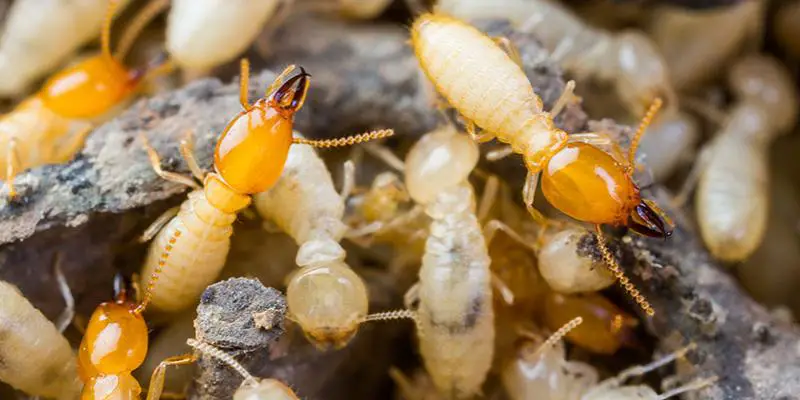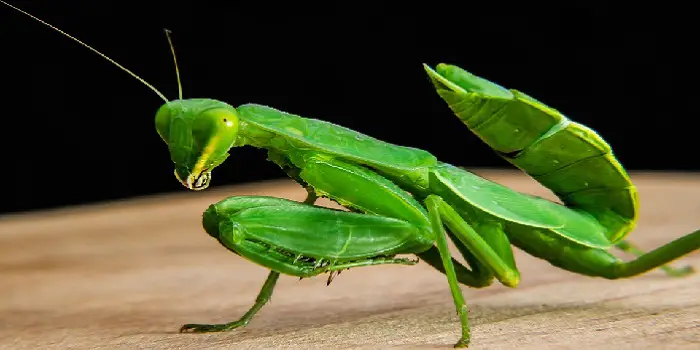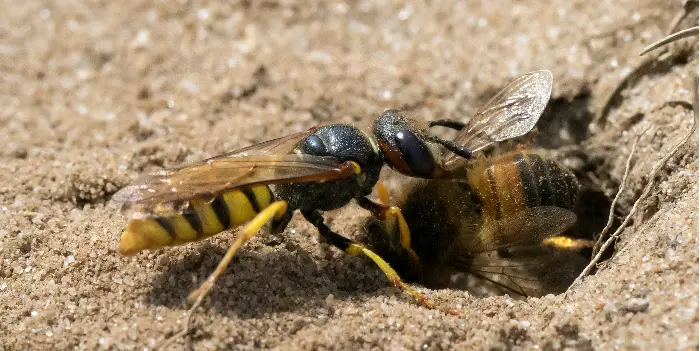
Ground bees are common in lawns and backyards.
Unless provoked, they do not tend to hurt humans or pets around.
If you know how to identify them and how to repel them naturally, they can be considered harmless pests for us humans.
In fact, ground bees have often been found to aerate the soil in your yard and prove helpful.
Since ground bees are not dangerous, it does not mean that they are not annoying, and you should leave them in your yard as such.
What Are Ground Bees – How to Identify Them?
Ground bees refer to 70% of the bee population, which may be housing in your ground.
The most common ones include bumblebees, cellophane bees, sweat bees, plasterer bees, and digger/mining bees.
They are opposite to honey bees (living in waxy nests) which people see around.
Many of these bees are individual nesters, meaning they don’t like living in their groups.
Even though they live alone, you may sometimes find many of them living in the place together.
What do they eat?
The list of common ground bees includes sweat bees, mining bees, leaf-cutters, masons, carpenter bees, digger bees, and others.
One essential thing you may need to know about the sweat bees is that they have earned this name and reputation because they get highly attracted to human sweat, and for this reason, they usually fly near human beings.
Ground bees generally feed on pollen and nectar.
Sweat bees like to eat human sweat, too, while honey bees love to eat honey in their larvae stage.
What do they look like?
Since ground bees are a general term that includes a lot of different species, we cannot expect all of them to have the same appearance.
Rather one of the simplest ways to recognize ground bees is to know what a bee looks like. Then you should see if you can find its nest or not.
A normal bee feature a short, round body with parts that include the head, thorax, along a small abdomen. Most of them have hair covering their abdomen and thorax.
Every bee also features six legs, eyes, and a pair of the sting, but they usually don’t bite.
Apart from these features, the ground bees can be of any size and color (like blue, black, red, yellow, purple, green, or even metallic color).
Do ground bees sting?
Usually, males don’t have stingers, but females do, but they don’t use them very often. If you get stung by them, it’s by the female and not the male.
A lot of bees die after stinging once, and female ground bees suffer from this issue.
Where do they like to stay?
One of the major characteristics of ground bees is the place where they live- yes, they live in the ground!
These bees dig small holes and hide out in tunnels just a few inches wider across.
Ground bees opt to make their home in dry soil rather than wet one.
They often choose to dig further into the tunnels already dug by rodents to make a hive.
The tunnels they make are more advanced and are connected to other cells.
People can find out about their habitat by noticing raised, loose dirt piles usually surrounding a hole that is just big enough for the bee to go inside.
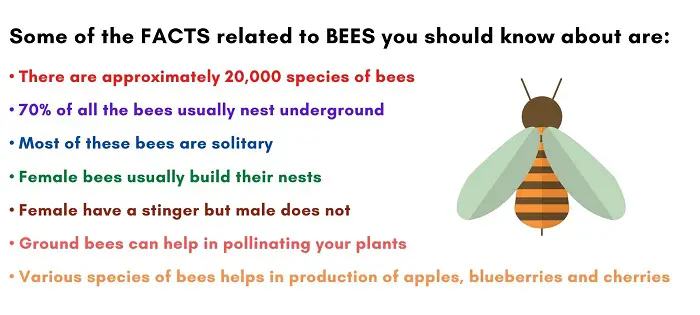
11 Ways to Get Ground Bees Out of Your Backyard
The conventional way of eliminating pests like ground bees usually involves the use of pesticides.
While effective and efficient, pesticides tend to be a non-discriminatory solution for getting out of ground bees, as they tend to kill even useful bugs, birds, and insects in the yard.
A natural pest control system is a much safer and better choice since it can target ground bees without leaving a residue that could harm the environment.
Here are ways how to implement a natural ground bees elimination and control program:
1. Eliminate trash
Garbage, particularly organic waste, attracts insects like ground bees in addition to rodents, and wild animals.
You should, therefore, try to use a sturdy garbage bin with a lid and dispose of trash properly.
Put food scraps and other biodegradable waste in sealed plastic bags. Dispose of dry and wet wastes separately to get rid of ground bees naturally.
2. Keep a tidy yard
Remove possible hiding and nesting places for ground bees outside of the house.
Piles of wood, cardboard boxes, old newspapers, and magazines offer a haven for ground bees, bugs, and small animals such as rodents.
Without these hiding places, ground bees will feel vulnerable and are less likely to build nests in the yard or near a home.
3. Get rid of standing water
Insects like ground bees and many others will often lay eggs in standing or slow-moving water, even the shallow ones on your lawn.
Sweep off the water that has collected in low-lying spots on the ground after the rain and throw away water that has collected in pots, old tires, or plant leaves.
Clean up old gutters and clogged drains.
4. Get rid of insect nests in the yard
Ground bees build nests in areas that are close to a food source.
If there are signs of infestation in a home or garden, that’s a sign these insects have already built a nest somewhere close by.
Preventing these insects from getting to their food source will encourage them to move elsewhere.
You can simply pour boiling water into the holes and entrances of insects/bees at night.
Using a cordless pest control repeller may also help you wonderfully in achieving this.
5. Cultivate a landscape that fights pests
Some plants and herbs are natural pest repellents for ground bees.
Many of these plants produce aromas or oils that are either deadly or unattractive to ground bees and other pests.
Some plants, such as the Venus flytrap, even help control insect populations by killing them naturally.
Try planting species such as rosemary, mint, catnip, and lemongrass to repel mosquitoes.
Marigold, a species that works well as a companion plant for vegetables, also works against these pests.
6. Allow natural predators to work
This is one good way to get rid of ground bees without chemicals.
Some bugs, bird species, and bats are natural enemies of harmful ground bees.
So you can attract them to work against the bees.
Some good bugs to encourage include ladybugs, honeybees, butterflies, dragonflies, praying mantis, earwigs, and parasitic wasps, to name a few.
7. Prevent access inside the home
Small insects like ground bees can easily burrow under the soil to find a way in through cracks.
These bees will need a hole that is only about a quarter of an inch wide in order to slip in.
Fix broken windows and doors and patch up cracks, holes, and crevices. Install screens and apply sealants to prevent bees naturally.
8. Sprinkle your lawn often
Regularly sprinkling your backyard garden is one of the easiest ways by which you can stop the ground bees from coming and making their homes in your yard.
Ground bees are often attracted to dry soil to nest there.
And they do not love to reside in damp areas or the grounds that are soaked/saturated with water.
Sprinkling your lawns more often will not only help in developing healthy grass but also keep the bees from the area.
They will then find some other place to get shelter.
9. Install bug zappers
Installing Zappers is a sure-shot option if you want to completely eliminate the ground bees from your yard.
There is a wide variety available on the market, and you can choose from anything between manual zappers, zapper rackets, and lanterns to electric bug zappers.
These attract and kill the bugs (such as bees, flies, wasps, etc.) immediately that will come in contact with them.
10. Clean up after feeding pets
Leftover food and water in pet bowls are targets for ground bees and other pests.
Always clean up after each feeding and change the water regularly. If possible, keep pet food bowls inside the house.
11. Control moisture inside the home
Leaky faucets and cracked pipes can create spots in the home that are permanently damp.
Moisture can corrode certain metals and cause wood to rot, attracting insects such as ground bees, cockroaches, and even carpenter ants.
Seal or replace cracked pipes and fix leaky faucets to prevent wet spots, especially in the basement or under the sink.
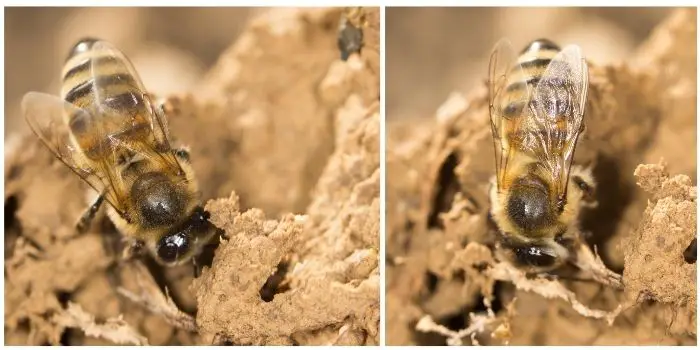
Few Home Remedies to Get Rid of Burrowing Bees
As mentioned before, pesticides can be harmful to use unless you have tried all other methods and have failed to get success.
Instead, use natural remedies like cayenne pepper, cucumber peels, extract of peppermint, soapy water, cinnamon (powder or sticks), mothball, or even chloroform.
These can help you get rid of bees if you want to avoid the use of pesticides on your lawn.
If you do not like the above remedies, you can also try preparing a DIY bee spray to repel them away naturally.
The spray mixture can be prepared as:
- Mix equal parts of vinegar and water in a spray bottle, shake it well
- Spray this mixture near every beehive in the ground at night, also sprinkle it on plants and flowers if you want
Few other common household items that can be used for preparing the easy homemade bee repellent spray include canella oil, mint oil, tea essential oil, and baby shampoo.
You can also sprinkle some garlic powder on the yard where you see the bees nesting.
Citronella candles can also be lit in the yard as their scent proves to be an effective bee repellent.
Few Commercial Ground Bee Repellent That Can Work
Due to the declining population of bees and their advantages for nature, I do not recommend killing them at any cost.
If home remedies don’t work for you for whatever reason, there are a few commercial bee repellents you can try.
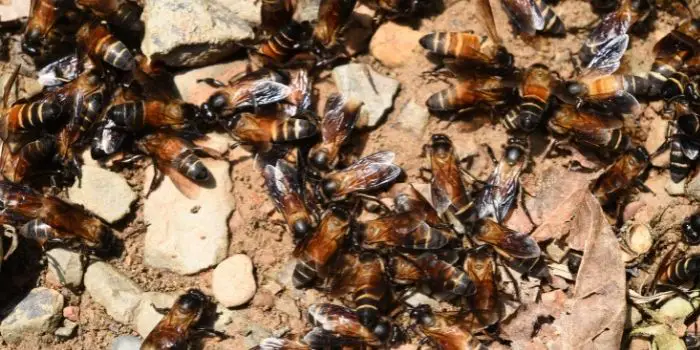
1. Burt’s Bees Insect Repellent
It’s a powerful yet Eco-friendly bee repellent that is safe to use in and around your home for complete bee removal.
You can spray it near your house to repelling not only bees but also other bugs and mosquitoes.
If you want, this can also be used on your skin (during your outdoor recreation) to avoid an unpleasant sting.
2. All Terrain Herbal Armor Spray
It’s manufactured using top-quality ingredients to offer you high protection from bees.
Available at an affordable price, it will help you protect yourself from dangerous insects, including a bee’s stung.
You can use this environmentally friendly & non-irritating spray on your skin while hiking or when relaxing in the backyard with your family.
These all-natural bee repellent products can be easily purchased from any household store near you or at online stores like Amazon.
It comes with all the required instructions you will need to follow.
One good thing that I like about these repellents is that they will keep the bees away from you while still allowing them to pollinate plants and flowers.
In case you are not satisfied with these two top-quality products, you can search for more like these on the internet.
There are tons of them available.
Make sure you do not ever try to pour any gas, gasoline, or other poisonous chemicals into the nest of the ground bees.
This can poison your ground and can kill plants and animals around.
What Should You Do if You are Stung by a Ground Bee?
Unlike wasps or hornets, burrowing bees are not so aggressive.
Especially the male ones that do not have the stingers are safe for humans and animals.
But that does not mean that you cannot get hurt by them. They can still hurt you if provoked.
Females who have stingers can sting you severely if irritated.
Remember, if you are stung by a ground bee, it may cause serious rashes and allergic reactions.
You should therefore call/visit a doctor to get the stinger removed immediately.
One good way to avoid getting stung by bees is by not getting close to them and avoiding walking barefoot outdoors in your backyard garden.
The Conclusion
Ground bees prefer to live alone, so it is highly uncommon for more than one bee to live in every hole in the yard.
People who deal with a large number of bees either have dozens of nesting ground bees, or there is a unique menace lurking over them.
If you or your family is struggling hard to deal with these ground bees in your yard, hopefully, the above tips and guide will help you get rid of them.
Share the post "11 Tips to Get Rid of Ground Bees in Your Yard (Naturally)"

Welcome to ProShieldPest.com. I am Tina Jones. I have been working as a pest removal professional in Winslow, Arizona lately. At present, I love to spend my time with my family as a retiree.
Here I share all my knowledge and experiences to help people understand better how they can stop pests at their homes without actually killing them. Hopefully, the information you will find here will help in safeguarding your home! You can check more about me here.

